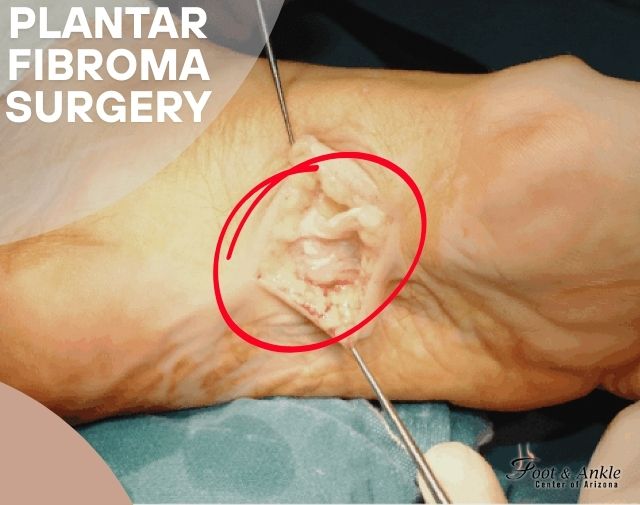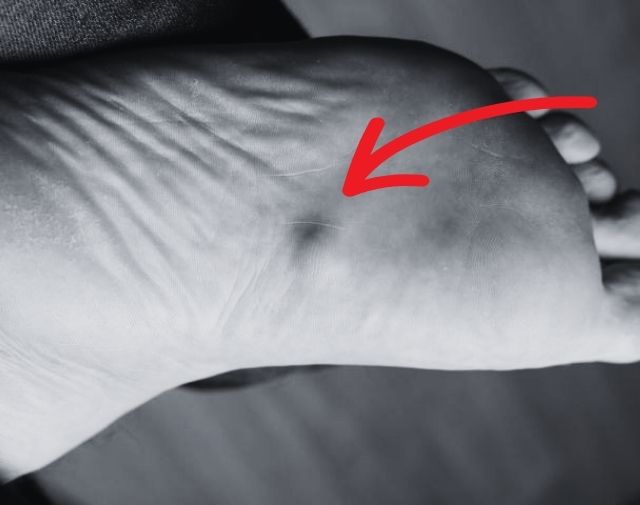Plantar Fibroma Surgery in Scottsdale, AZ
Specialized Surgical Treatment for Persistent Arch Pain
If you have a firm bump in the arch of your foot that is painful on walking, standing, or even shoe-wearing, you may have a plantar fibroma. While benign, the condition can become painful and intrusive with time. At the Foot and Ankle Center of Arizona, we offer expert evaluation and treatment, including plantar fibroma surgery if necessary, to regain your mobility and comfort.
Led by Dr. Kris A. DiNucci, DPM, FACFAS, board-certified foot and ankle specialist with more than 25 years of practice, our Scottsdale clinic provides patient-focused care with assured outcomes.

What Is a Plantar Fibroma?
A plantar fibroma is a benign growth that occurs on the plantar fascia, the thick band of connective tissue that runs along the underside of the foot. A plantar fibroma is not a soft tissue lump that arises on the skin surface, but a nodule within the fascia itself, making it firm and fixed.
Although it can occur in anyone, plantar fibromas are more commonly seen in middle-aged individuals and may be linked to genetic predisposition, recurrent trauma, or systemic conditions such as Dupuytren’s contracture.
Symptoms of a Plantar Fibroma
Not all plantar fibromas cause pain initially, but as the fibroma grows or as pressure is applied to the affected area, symptoms can worsen. Common signs include:
- A noticeable, firm lump in the arch of the foot
- Discomfort when walking, especially barefoot or on hard surfaces
- Pain when pressure is applied directly to the lump
- Difficulty wearing shoes due to arch irritation
- Gradual worsening of symptoms over time
If you’re experiencing these issues, a thorough examination and imaging may be needed to confirm the diagnosis and determine the best course of action.
Diagnosing a Plantar Fibroma
Diagnosis begins with a physical exam, where the position, size, and density of the lump are assessed. Imaging such as ultrasound or MRI may be used to differentiate a plantar fibroma from other soft tissue tumors like cysts or lipomas. Early diagnosis is responsible for the management of symptoms and the exploration of non-surgical options before surgery.
Conservative Treatment Options
Before recommending plantar fibroma surgery, our team always explores non-invasive treatments to help relieve symptoms. Conservative options include:
- Custom orthotics to reduce pressure on the fibroma
- Stretching exercises for the plantar fascia
- Physical therapy to improve foot biomechanics
- Anti-inflammatory medications
- Corticosteroid injections to shrink the fibroma temporarily
While these methods can provide relief for many patients, they may not resolve the fibroma itself. If pain persists or worsens, surgery may be necessary.
When Is Surgery Necessary?
Plantar fibroma surgery is typically recommended when:
- The fibroma continues to grow
- Conservative treatment has failed to relieve pain
- The patient experiences significant difficulty with walking or wearing shoes
- The fibroma interferes with quality of life or daily activities
Surgical intervention provides a more permanent solution by removing the fibroma entirely and, if needed, a portion of the affected fascia to reduce the risk of recurrence.
What to Expect During Plantar Fibroma Surgery
Surgical removal of a plantar fibroma is performed on an outpatient basis. Local anesthesia with sedation or general anesthesia is utilized based on the case.
During the operation, the fibroma is excised with gentle care, along with a minor rim of adjacent tissue. This helps eliminate it totally, minimizing the possibility that it will recur. Dr. DiNucci makes careful surgical movements in order to save adjacent structures and allow for an uncomplicated recovery.
Postoperative Recovery and Care
Recovery after plantar fibroma surgery typically includes:
- Wearing a surgical shoe or walking boot for several weeks
- Elevating the foot and limiting weight-bearing activity
- Gradual return to walking, followed by physical therapy if needed
- Follow-up visits to monitor healing and progress
Most patients can return to normal activities within six to eight weeks. The recovery time may vary for the person and extent of surgery.
Our team provides detailed postoperative care instructions and guidance throughout your recovery to ensure the best possible results.
Potential Risks and Considerations
As with any surgical procedure, there are some risks involved with plantar fibroma surgery, including:
- Scar tissue formation
- Nerve sensitivity or numbness in the area
- Recurrence of the fibrom
- Mild changes in foot structure or gait
- Infection or delayed wound healing (rare)
At the Foot and Ankle Center of Arizona, we prioritize patient education and safety. Dr. DiNucci will discuss all risks, benefits, and expectations during your surgical consultation.
Why Choose the Foot and Ankle Center of Arizona?
Dr. Kris A. DiNucci and his team are committed to providing exceptional surgical care and personalized treatment plans for each patient. With a long-standing reputation for excellence in the Scottsdale and Phoenix area, our center has helped thousands of patients overcome foot and ankle conditions with confidence.
- Over 25 years of surgical expertise
- State-of-the-art facility and diagnostic tools
- More than 1,000 five-star patient reviews
- Recognized by Phoenix Magazine as one of the Top Foot Doctors for 16 years
When you choose us, you can expect thorough evaluation, honest advice, and skilled surgical care tailored to your unique needs.
Schedule a Consultation Today
If you are suffering from persistent arch pain or a lump on your foot that is interfering with your daily life, it may be time to start looking at your options. Surgery for plantar fibroma may be the step that gets you walking comfortably again.
Call the Foot and Ankle Center of Arizona today to schedule a consultation with Dr. DiNucci. Reach us or book an appointment.
